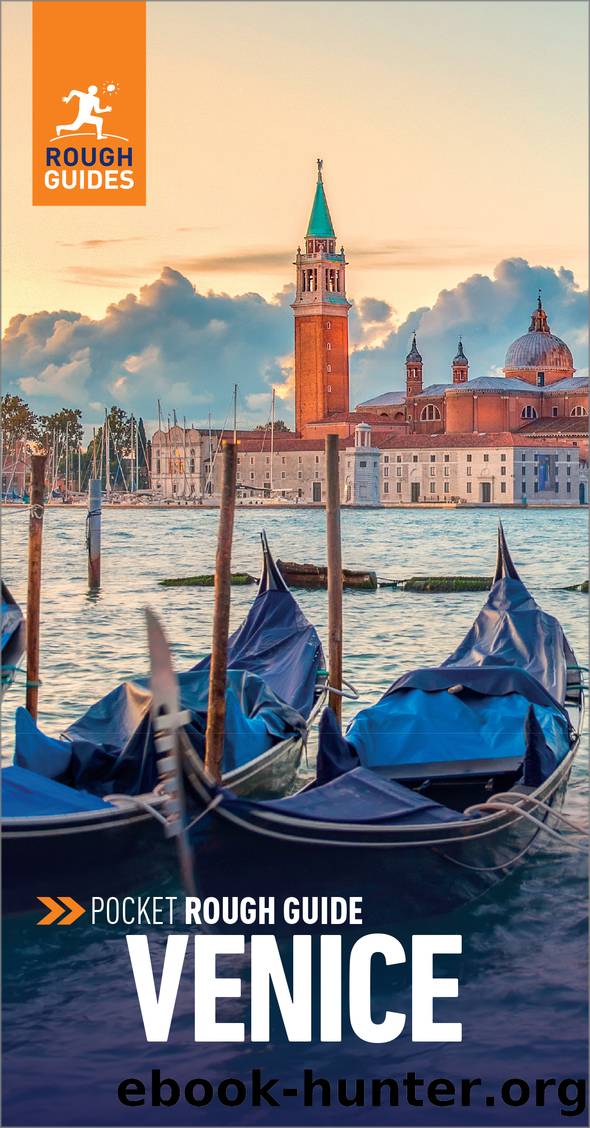Pocket Rough Guide Venice by Rough Guides

Author:Rough Guides
Language: eng
Format: epub
Tags: Travel, Italy
Publisher: Apa Publications
Published: 2024-04-06T10:10:15+00:00
Santi Giovanni e Paolo
MAP
Campo SS Giovanni e Paolo santigiovanniepaolo.it. Charge.
Like the Frari, the massive Gothic brick edifice of Santi Giovanni e Paolo â slurred by the Venetian dialect into San Zanipolo â was built for one of the mendicant orders, whose social mission (preaching to and tending the sick and the poor) required a lot of space for their congregation. The first church built on this site was begun in 1246 after Doge Giacomo Tiepolo (d.1249) was inspired by a dream to donate the land to the Dominicans. Tiepoloâs simple sarcophagus is outside, on the left of the door, next to that of his son Doge Lorenzo Tiepolo (d.1275); the cavernous interior â approximately 90m long, 38m wide at the transepts, 33m high in the centre â houses the tombs of some 25 other doges.
Most of the entrance wall is given over to the glorification of the Mocenigo family, with three monuments to fifteenth-century doges from this dynasty. But the finest funerary monuments are in the chancel, where Doge Michele Morosini, who ruled for just four months before dying of plague in 1382, is buried in the tomb at the front on the right, a work which to Ruskinâs eyes showed âthe exactly intermediate condition of feeling between the pure calmness of early Christianity, and the boastful pomp of the Renaissance faithlessnessâ. Full-blown Renaissance pomp is represented by the tomb of Doge Andrea Vendramin (d.1478), diagonally opposite, while one of the earliest examples of Renaissance style in Venice â Pietro Lombardoâs tomb for Doge Pasquale Malipiero (d.1462) â is in the left aisle, to the left of the sacristy. (The sacristy itself contains an excellent painting, Alvise Vivariniâs Christ Carrying the Cross.) The Lombardo family were also responsible for the tombs of Doge Giovanni Mocenigo and Doge Pietro Mocenigo, to the right and left of the main door. Close by, the second altar of the right aisle is adorned by one of Zanipoloâs finest paintings, Giovanni Belliniâs SS Vincent Ferrer, Christopher and Sebastian.
At the top of the right aisle, Giambattista Piazzettaâs St Dominic in Glory covers the vault of the Cappella di San Domenico, alongside which is a tiny shrine containing a relic of St Catherine of Siena. She died in 1380 and her body promptly entered the relic market â most of it is in Rome, but her head is in Siena, one foot is here, and lesser relics are scattered about Italy. Round the corner, in the south transept, two other superb paintings hang close together: a Coronation of the Virgin attributed to Cima da Conegliano and Giovanni Martini da Udine, and Lorenzo Lottoâs St Antonine (1542).
And donât miss the Cappella del Rosario, at the end of the north transept. In 1867 a fire destroyed its paintings by Tintoretto, as well as Giovanni Belliniâs Madonna and Titianâs Martyrdom of St Peter, San Zanipoloâs two most celebrated paintings. A lengthy restoration made use of surviving fragments and installed other pieces such as Veroneseâs ceiling panels and an Adoration on the left of the door.
Download
This site does not store any files on its server. We only index and link to content provided by other sites. Please contact the content providers to delete copyright contents if any and email us, we'll remove relevant links or contents immediately.
Spell It Out by David Crystal(36081)
Underground: A Human History of the Worlds Beneath Our Feet by Will Hunt(12049)
A Year in the Merde by Stephen Clarke(5365)
Venice by Jan Morris(2544)
Claridge's: The Cookbook by Nail Martyn & Erickson Meredith(2377)
My Paris Kitchen: Recipes and Stories by Lebovitz David(2268)
A TIME OF GIFTS by Patrick Leigh Fermor(2173)
The Plantagenets by Dan Jones(2056)
Welcome to the Goddamn Ice Cube by Blair Braverman(2011)
The Finnish Way by Katja Pantzar(1957)
Top 10 Prague (EYEWITNESS TOP 10 TRAVEL GUIDES) by DK(1952)
From Russia with Lunch by David Smiedt(1946)
Bang Poland: How To Make Love With Polish Girls In Poland by Roosh V(1944)
The Isle of Mull by Terry Marsh(1911)
A TIME TO KEEP SILENCE by Patrick Leigh Fermor(1880)
Rick Steves London 2018 by Rick Steves & Gene Openshaw(1835)
A Taste of Paris by David Downie(1830)
Insight Guides Experience Tokyo by Insight Guides(1828)
Merde in Europe by Stephen Clarke(1736)
